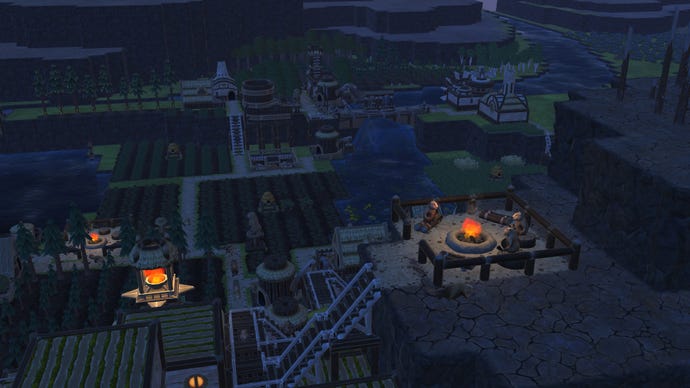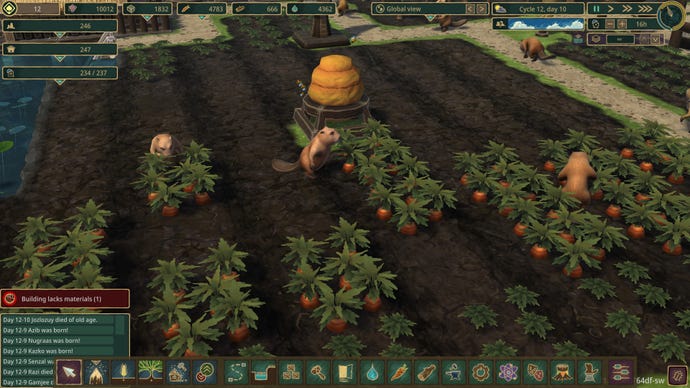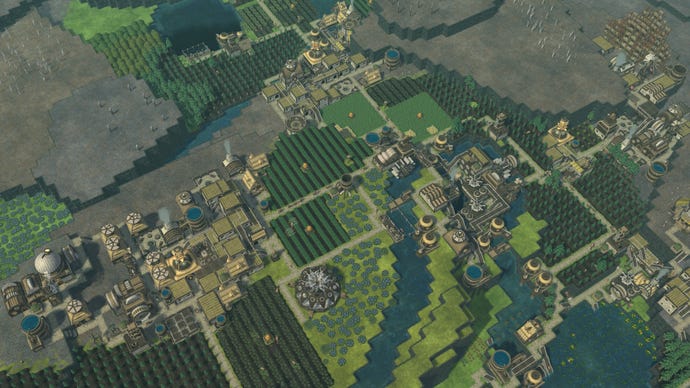The Rally Point: Timberborn breaks the boring "village vs winter" mould
I want to le beave
I think I'm tired of winter.
It's not the cold. It's not even the lack of anything to do. It's that when your main threat is starvation and hypothermia, and your only real tool is stockpiling, it often feels like your fate is already sealed come October, and waiting around to see if you survived or not carries the same sense of slow inevitability that the average RTS or 4X game does past the opening act.
My first village in Timberborn gave me that feeling. Even though its dry season is the opposite of Winter, the ultimate effect was the same. I've played this before, I thought. This is the villagers vs winter game again.
I was a fool. A big, wrong fool.
My initial complaint comes up often in survival-based building games. The ones where you settle in a wilderness and have to quickly gather enough wood and food to last through winter, and that's typically all the game's about. The issue I have isn't when they're difficult, but when there's no leeway. When you reach a point where you need three wood to build the last granary, but you only have two wood, and therefore your entire settlement is now mathematically doomed. Does nobody in this village want to live? Faced with the starvation of your entire family, would you stare at the woodcutter's hut with the big sign reading "3 / 3 workers", and the fields full of crops, and the two-thirds of a building to store them in, and simply resign yourself to death?
It's a tricky feeling to elucidate but you know it's happening when you have no option but to watch your game slowly fall apart and your society die out because of a technicality. It’s not even about “difficulty”, but degree of entertainment. When your hands are tied in a way that feels artificial and dissatisfying, and when there's no amusement or awe to be had from watching the tower collapse. Losing, essentially, is not fun.

It's an awkward complaint. What am I asking for, the game to play itself? For my problems to be magically solved by enterprising peasants? For games about preparation to cut out preparation? Ach. I guess the main thing is I'm tired of playing Banished again. No disrespect to Banished, but I never got on with it. Perhaps I got lucky, but I survived the winters fine, and the game seemed to consist mostly of repeatedly moving workers back and forth while yelling at them to breed faster, like a hybrid of an understaffed CEO and a 30 year old's pushy mum.
And yet, I love Workers & Resources, in which you will lose your first town by failing to anticipate how to set up public heating infrastructure (my favourite village largely forestalled this as the modded huts came with their own heating system, simulating villagers gathering their own firewood at the cost of poorer health). I voluntarily played RimWorld almost exclusively as a desert mountain tribe who refused electricity, struggling to eke crops out of the thin, scattered patches of arable land, and balance the tiny fuel supply between preserving enough food and keeping the cave warm. And that's a game where people will kill each other over idiotic nonsense like not eating at a table.

But I think that's the key: those games had more to do than watching to see who would survive the cold. Or consider Ostriv, where the watching itself was a delight. They all have things to delight in, and that's where Timberborn really shines once you realise what it's doing.
You are beavers. Humanity has long gone, and it's your time to shine by building a settlement that isn’t all that different, really. Forage for berries, chop trees, build dens so people will breed, then build a science hut to unlock new stuff. Build a sawmill, plant crops, plant new trees, etc, etc. In place of Winter though, your looming threat is drought. Every 15 days or so, the water coursing through each map dries up. Land that previously bordered water turns from a precious, plant-bearing green to a cracked and alarming grey. Plants wither and die, and any beaver town left with no water dies. You fool.
Droughts never overtake wet seasons the way Endless Legend's ice gradually consumed the game, but without large stockpiles you will fail. Although simple in theory, providing that storage will likely hit that dynamic I mentioned earlier for your first couple of games, because every building requires wood, and wood takes a very long time to grow. Fundamentally, it is wood, not water or food that your future is built on. And the key to it is water.

For that is the second thing that defines why Timberborn is special. The fact that your people are beavers is largely immaterial, and yet it's critical thematically. What do beavers do? They build dams. And so must you. Water, you see, does not simply disappear come the drought. Water sources dry up, but those sources are blocks like the ones in Dwarf Fortress. And once it leaves a source, the water flows. It spreads to neighbouring squares, falls downhill, slows when obstructed, and rushes when compressed through a narrow channel.
And channel you will, because dead land touched by water becomes more places for trees and crops. You might, like me, take a few goes to get a feel for the amounts needed, and the planning involved. More importantly, you'll realise you were looking at it wrong; instead of thinking about water storage, you should have analysed the shape of the land. Dams and levies and floodgates can transform the world even before you unlock terraforming dynamite (which I've barely even touched after dozens of hours, such is the power of the dam). Moving water drives wheels that power your industry. Blocked water spreads welcoming grass, turns flooded plains into beds for special aquatic crops, and provides mass storage you can pump up into local stockpiles as needed. And at some point you'll realise that you can't merely build a second layer of housing and catwalks and stairs; you can pile dozens of layers atop one another, building huge towers of busy beavers and their supplies, driving your need for greenery and water ever higher.
Timberborn, you see, is not just about surviving the drought. It's about how the drought teaches you what you're capable of if you learn how to look at what's around you. My biggest obstacle is choosing between the multiple possibilities I see, like when I find a new area in Minecraft and immediately feel my ideas fighting over which gets to snatch the next month of my life, despite this game's fixed maps and far fewer parts. When you can keep building over so many layers, the sky is almost literally the limit. And any time you feel satisfied with an area, there's no reason not to let it spore into a new, self-sufficient district.

That's another design feature I didn't appreciate at first. When you spread wide enough things move slowly, and it becomes time to place a new district. Instead of a discrete colony building, you can place a new depot for free anywhere, then define a point on your roads where the new district begins. Thenceforth, it becomes a separate town, with its own population and storage. Special buildings can be used to send supplies back and forth, and migration happens on your command, but each district is administered separately, and they're defined by where you connect roads, not dictated by a radius or arbitrary numbers. You can build an entire new town and split it in two, send a few colonists to start from scratch, or totally isolate an area from its peers. I have one district on a clifftop, a dozen levels above its new neighbour, which I've spent a week building up to fill the gap between them until at last, beavers from each district can rest literally back to back and stare out over the flourishing fields and maple forest below. A third district lives exclusively on aquatic produce, and a fourth is budding at the foot of a staircase taller than ten houses.
And it's water that's key. Instead of the winter, an abstract thing that merely removes supplies, Timberborn uses drought to encourage you to see the possibilities its water provides. Use it while it's here, and you'll even get to keep it. And it's perfectly tied in with that wonderful verticality, turning the spatial challenge of spreading a town outwards into a structural one of layering platforms over paths, bridges over mills, and little overlapping dens wherever I can squeeze more in. My towns feel like something of my own.This little place is recognisably mine, because I had so much control over its shape. That third dimension adds so much room for expression as well as function. You can even communicate ideology with it, inferring what a settlement values by how it's chosen to use its space. I always build around the land in these games, reluctant even to build over natural forests. Normally this is hugely constraining, but here I'm invited to work around the terrain and use it to my advantage. Instead of a sprawling mess awkwardly strung around rocks and trees, or worse, a boring, efficient grid-shagging bureaucrat's idea of a town, I can build up, and thus I create needlessly elaborate warrens with a visible history, local preferences and ideas.
I sometimes fear that I've moved on from building games, but I think I was merely held up in a mire of slight variations on the same idea. I feel like a fool for not even recognising how different Timberborn was at first, but I'm glad it opened the floodgate to let me out.


